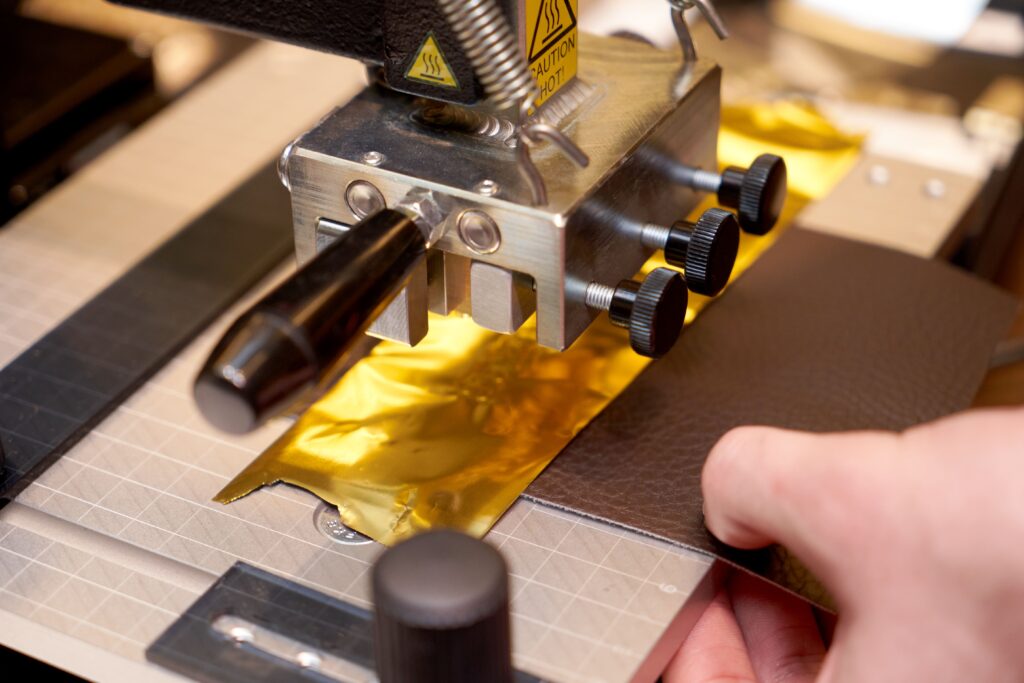

Hot foil stamping is a printing technique that’s been around for quite some time now. Its ability to add a touch of elegance and luxury to various products has made it a staple in the printing industry. So what is it, and how exactly does it work?
Hot foil stamping is a specialised printing method that uses heat, pressure, and metallic or pigmented foil to create a shiny, embossed design on various materials. This technique is widely used to add a luxurious touch to products like invitations, business cards, book covers and packaging. The result is a stunning, high-quality finish that stands out and adds visual appeal.
The primary equipment used in hot foil stamping includes a hot foil stamping machine, a metal die and foil rolls. At companies like Metallic Elephant, hot foil stamping machines are designed and built by hand to ensure top-notch quality and performance. These machines vary in size and configuration, but they all serve the same purpose: to transfer foil onto a substrate using heat and pressure.
The Process
Step 1: Design Preparation
The first step in the hot foil stamping process is preparing the design. This involves creating a digital design that will be transferred onto the metal die. The design can be anything from intricate logos and text to detailed graphics. Graphic design software is typically used to create and finalise the design, ensuring it meets the desired specifications.
Step 2: Die Creation
Once the design is ready, it is transferred onto a metal die. The die acts as a stamp, pressing the foil onto the substrate to create the embossed design. Dies can be made from various metals, such as brass or magnesium, and are etched or engraved with the design. The quality of the die is crucial, as it directly impacts the precision and detail of the final stamped design.
Step 3: Foil Selection
Choosing the right foil is a critical step in the hot foil stamping process. Foils come in a wide range of colours and finishes, including metallics (like gold, silver, and bronze), pigmented colours, holographic patterns, and even clear foils. The choice of foil depends on the desired effect and the material being stamped. Foils are typically available in rolls, making it easy to load them onto the stamping machine.
Step 4: Machine Setup
With the die and foil ready, it’s time to set up the hot foil stamping machine. The die is attached to the machine, and the foil roll is threaded through the machine’s feeding mechanism. The machine is then calibrated to the correct temperature and pressure settings, which vary depending on the type of foil and substrate used. Proper calibration is essential to achieving a clean, crisp, stamped design.
Step 5: Stamping Process
The substrate, which could be paper, cardboard, leather, or another material, is placed into the machine. The heated die is then pressed onto the foil and the substrate, causing the foil to adhere to the substrate in the desired pattern. The combination of heat and pressure ensures that the foil bonds firmly to the substrate, creating a durable and visually appealing design.
Step 6: Finishing Touches
After the stamping process is complete, the substrate is removed from the machine. Any excess foil is peeled away, leaving behind a clean, embossed design. Depending on the project, additional finishing processes such as embossing or debossing may be applied to enhance the final result further. These finishing touches add depth and texture, making the design even more striking.
Types of Dies Used in Hot Foil Stamping
There are different types of die, and they each have their own unique characteristics and applications:
- Magnesium Dies: Magnesium dies are a cost-effective option for hot foil stamping. They are relatively easy to produce and are ideal for short to medium print runs. Magnesium dies are lightweight and can achieve good detail, making them suitable for various applications.
- Brass Dies: Brass dies are known for their durability and precision. They are more expensive than magnesium dies but offer superior quality and longevity. Brass dies are ideal for long print runs and projects that require intricate designs with fine details. Their robustness makes them a popular choice for high-end printing projects.
How Are Hot Foil Stamping Being Used?
Hot foil stamping is utilised across various industries to enhance the visual appeal and perceived value of products. In the wedding industry, hot foil stamping is commonly used to add a touch of elegance to wedding invitations, making them stand out with their shimmering metallic finishes. Businesses can also benefit from hot foil stamping for business cards or marketing material to make a memorable first impression. The luxurious finish of foil-stamped business cards can convey professionalism and quality.
In the publishing industry, book covers often feature hot foil stamping to create eye-catching titles and decorative elements. The metallic and embossed details add a layer of sophistication and help the books stand out on the shelves. High-end packaging frequently incorporates hot foil stamping to create a premium look for products.
Embrace the Elegance of Hot Foil Stamping
Hot foil stamping is more than just a printing technique, it’s an art form that adds elegance and sophistication to your printed materials. Whether you’re looking to create wedding invitations, eye-catching business cards, or luxurious packaging, hot foil stamping offers a versatile and visually appealing solution.
At Metallic Elephant, we’re passionate about hot foil stamping and the difference it can make in your projects. Get in touch with us today and speak to someone on our team about hot foil stamping!